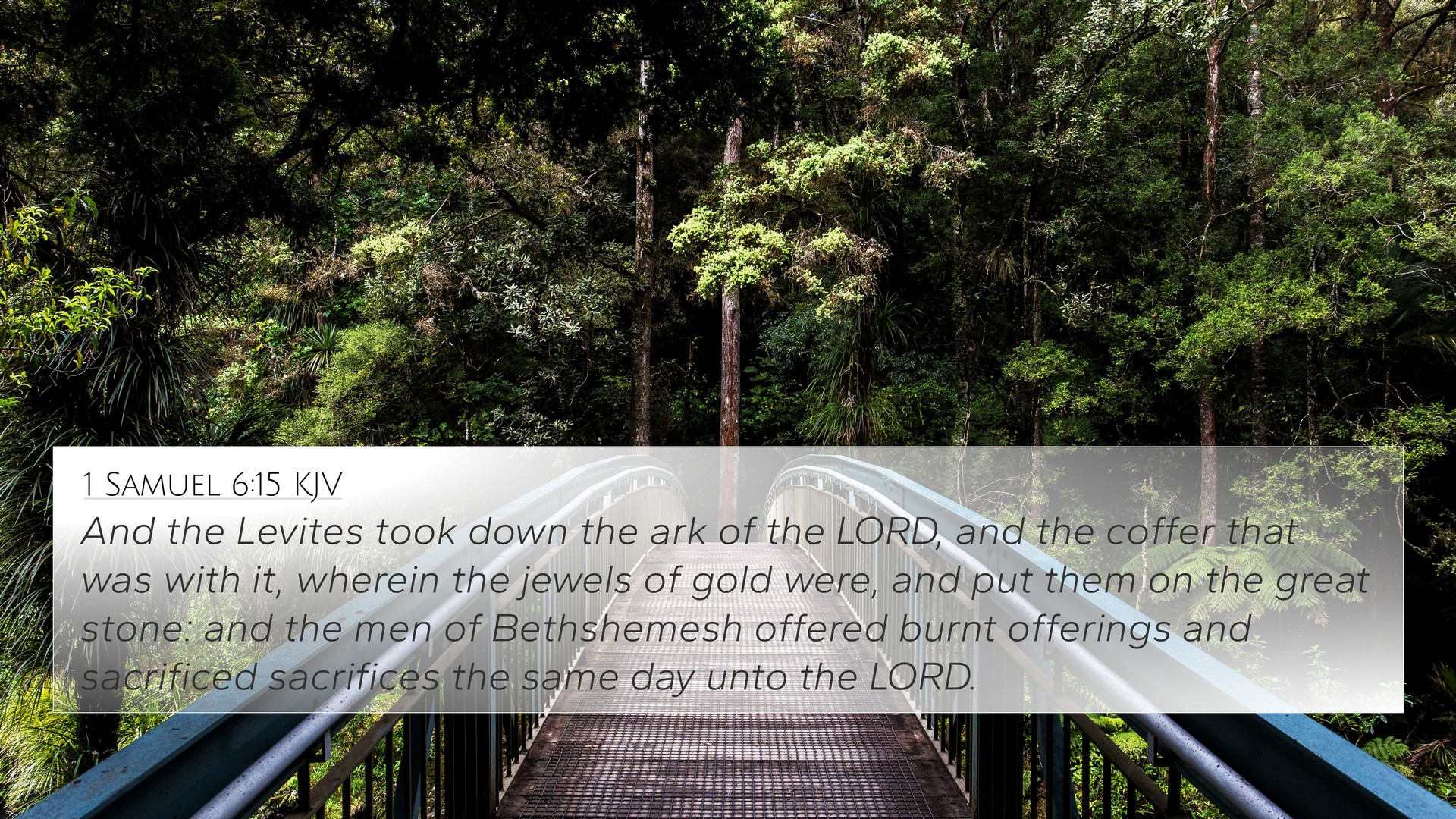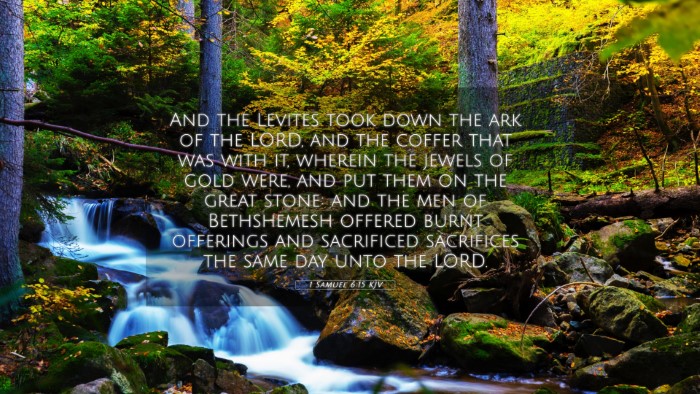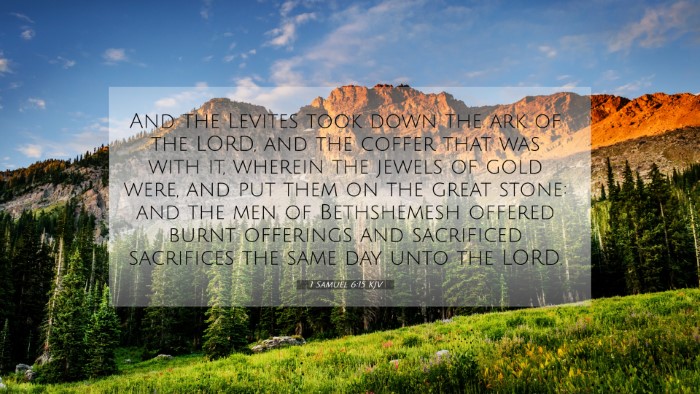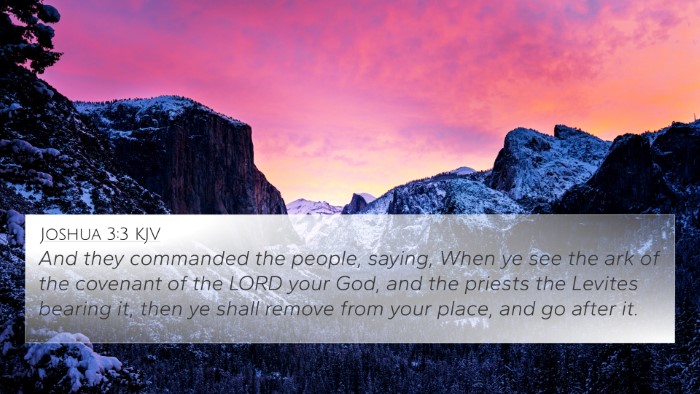Understanding 1 Samuel 6:15
Verse: "And the Levites took down the ark of the LORD, and the chest that was with it, wherein the jewels of gold were, and put them on the great stone. And the men of Bethshemesh offered burnt offerings and sacrificed sacrifices the same day unto the LORD."
Summary of the Verse
1 Samuel 6:15 describes an important moment in the biblical narrative where the Levites handle the Ark of the Lord after its return. The actions of the Levites and the men of Bethshemesh signify reverence and thanksgiving to God for the return of what was lost, showcasing themes like divine mercy and obedience.
Commentary Insights
Matthew Henry’s Commentary
Matthew Henry emphasizes the significance of the Ark's return and how the Levites are entrusted with its handling. He reflects on the role of the Levites in Israel's worship and notes that their duties included sacred responsibilities. The sacrifices offered by the men of Bethshemesh illustrate their gratitude for God's deliverance, showing a communal response of worship.
Albert Barnes’ Notes
Albert Barnes points out the procedural elements of how the Ark was returned and the associated treasures that came with it. He highlights the importance of an orderly approach to worship and sacrifice, indicating that reverence is crucial in the presence of God. Barnes also suggests that this moment exemplifies God’s continuing relationship with His people, encouraging them to acknowledge His sovereignty.
Adam Clarke’s Commentary
Adam Clarke provides insight on the cultural practices surrounding the Ark. He notes that the sacrifices made are a fulfillment of Israel’s covenantal relationship with God. Clarke describes the great stone as a place of significant worship, and the offerings symbolize a fresh start, illustrating restoration after a time of conflict and loss.
Thematic Connections
This verse has thematic connections to several other scriptural passages that reflect on worship, sacrifices, and the importance of the Ark of the Covenant:
- Exodus 25:22 - This verse outlines God's promise to meet with His people above the Mercy Seat, emphasizing the Ark's role as a divine meeting place.
- Numbers 3:6-9 - Details the responsibilities of the Levites, integrating the understanding of their duties in relation to the Ark.
- 1 Chronicles 15:14-15 - This passage discusses the careful way the Ark should be handled, reaffirming the sanctity and the fear of God associated with it.
- Psalm 99:1-3 - It speaks to the reign of the Lord and His holiness, linking to the celebratory sacrifices offered in our verse.
- Hebrews 9:4 - Reflects on the items contained in the Ark, serving to highlight its significance in the New Covenant as well.
- 2 Samuel 6:12-15 - Another instance of the Ark being brought into a holy city, indicating the communal joy and worship surrounding it.
- Leviticus 1:1-9 - Outlines the principles of burnt offerings, providing a deeper context for the sacrifices mentioned in 1 Samuel 6:15.
Cross-Referencing Insights
The act of cross-referencing provides a deeper understanding of biblical texts. The connections between these verses establish a narrative thread through the Old and New Testaments, emphasizing themes such as divine interaction and sanctity in worship.
Methods for Cross-Referencing
Utilizing a Bible concordance or a cross-reference guide can assist in identifying and exploring these connections. When studying passages like 1 Samuel 6:15, employing tools like:
- Bible concordance
- Cross-reference Bible study tools
- Comprehensive Bible cross-reference materials
helps facilitate a deeper understanding of inter-Biblical dialogue and thematic connections.
Practical Applications
Reflecting on 1 Samuel 6:15 encourages one to recognize the importance of worship and gratitude in everyday life. This passage calls believers to:
- Honor God's presence through reverent worship.
- Understand the significance of sacrifice and gratitude.
- Explore connections between Scripture for a more profound insight into God’s nature.
Conclusion
In summary, 1 Samuel 6:15 serves as a poignant reminder of God's faithfulness and the appropriate response of His people through worship and sacrifice. By understanding the cultural and theological significance of this moment, we can draw connections throughout Scripture that enrich our faith and understanding.



